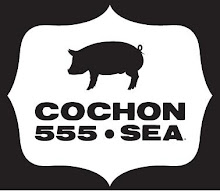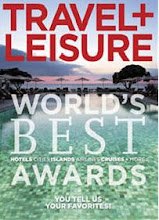French Canadian Julian Rose is a master chocolatier and the director of research & development for Portland’s Moonstruck Chocolates. Julian is classically trained both in pastry and confections and is a highly regarded authority on chocolate. Dessert Professional magazine recently named him one of the top ten chocolatiers in North America.
I reached out to Julian, hoping to snag a list of his most influential cookbooks. His response was brief and the book choices weighed heavily on molecular gastronomy. While science is a major component for confectioners, his list surprised me. I arranged a call with Julian, hoping to learn more about him and the motivations behind his list.

Julian turned to molecular gastronomy…seeking “a complete approach to food.”
“It’s a conscious decision.”
In school, he found instructors offered insufficient answers to his questions, “We do it this way because…that’s what you do.”
“I wanted to understand why things worked—not ‘just because.’” He adds, “I don’t push molecular gastronomy, but it’s the foundation of the way food reacts.”
Julian is quick to acknowledge that molecular gastronomy has its pros and cons. “It’s a mistake to do 100% molecular gastronomy.” Balancing science and traditional technique, he emphasizes, “You need to put your soul into it the food.”
After graduating from culinary school, Julian specifically sought out mentors who would explain pastry techniques in depth. While he admired their knowledge, he adds, “Their jobs were easier because they understood the food.”
“Every chef has access to the same ingredients—some pull it off better than others.” Why? It’s in the science.
Mentor Jacques Belanger was a master craftsman in France, and taught specialty classes at the culinary academy. “I took four of his classes. He was approachable and down-to-earth. Happy to share information—a quality I admired.” As Julian explains, he developed entire classes on eggs. “It was fascinating!” Belanger emphasized that timing was critical. When eggs were added to a dish had an effect on the final products’ structure. “For example, egg yolks cook differently than egg whites.”
Turning to his list of books, Julian notes a self-titled copy by Paco Torreblanca. “Paco cooks for the king and queen of Spain and he’s very generous with recipes.” His voice builds with a harnessed enthusiasm, “I asked him for his very best chocolate cake and he gave it to me!”
While some chefs are notoriously secretive with their recipes, Julian takes an opposing view, “Sharing [recipes] makes you better. It’s out there for the world…and it pushes you to be better.”
Julian sheds light on Paco’s career. “He used to be a culinary chef but he didn’t derive pleasure from it. Pacco is very exact and he wasn’t getting satisfaction from being a culinary chef. But in baking, there’s a big difference between 10 milligrams and 15.
Because of his culinary background, he has an interesting approach to pastry. He uses flavor associations that are very different--utilizing herbs and savory spices.”
He continues, “Paco’s presentations are also very naked and yet delicate in the way he holds back. For example, he uses a crystallized branch of rosemary on a cake. You open the box and get a whiff of rosemary. It creates a desire and you immediately want to eat the cake.
Everything Paco does is spot on—there’s nothing neglected. For example, his boxes are black with a small window so you can see a tiny view of what’s inside. It’s the right box. Everything is spot on. For him, there is no other way. From the moment he gets up in the morning, he’s a professional. He would not do less, because he would not be satisfied.”
Within the context of food, Julian says, “I am both a sculptor and a painter.” Exposing the vulnearable nature of the artist, he adds, “Inside, you’re never happy with what you express on the outside. It never comes to life exactly the way you wanted it to be—the perfect expression.”
Julian picks up momentum and sums, “There’s a fine line between ‘artists’ and ‘chefs.’” It’s the creative drive that fuels the passion. “You have to be an artist to be in this business.”
Traca’s note: I’m intrigued by the process of moving from idea to expression and I asked Julian, “How do you capture your ideas?”
“I carry a voice recorder with me.” His voice trails off. “Sometimes I get inspired standing on the corner of a street. I used to try remembering those bits of inspiration and by the time I put pen to paper, it was lost. A friend of mine bought me that tape recorder and I carry it with me everywhere. So when I’m standing on a street corner…or wherever I am, I can capture those ideas. I play back the tape and record those ideas in my notebook.
When I have a dry spell, it’s a source of inspiration.”
--
Most Influential Books:
Fine Chocolate, Great Experience by Jean-Pierre Wybauw This is a wonderful book on fine chocolate and one of the first books to explore the science of chocolate on all facets.
Molecular Gastronomy by Herve This This one is not exactly a cook book but a food science book with in depth relations to food transformation. Herve This is the grandfather of molecular cuisine and trend setter!
The Science of the Oven by Herve This This is a great book exploring the science behind cooking. It has the fundamental explanations on how food reacts to heat and cold.
Taste Buds and Molecules by Francois Chartier This is a book exploring the taste buds and how the perceive flavors. Then by taking a given wine, tells you how to compose a flavor association in a menu. (French, not available in English. Read comments here.)
Paco Torreblanca by Paco Torreblanca This recipe book is a very progressive pastry bible from one of Europe’s best pastry chefs from Spain. Paco has a natural sense of aesthetics and flavor association like no one else!
Biography:
CHEF JULIAN ROSE
Master Chocolatier and Director of Research & Development
Moonstruck Chocolate Co.
World-renowned chef Julian Rose joined Portland-based Moonstruck Chocolate Co. as its Master Chocolatier and Director of Research and Development in October 2007. Chef Rose is a classically educated pastry chef and confectioner who is known the world over as an authority on chocolate, and he brings more than 25 years of experience to his position with Moonstruck Chocolate Co.
As Master Chocolatier and Director of R&D at Moonstruck Chocolate Co., Rose is responsible for developing new products, refining existing ones and ensuring the utmost quality of the entire Moonstruck Chocolate Co. product line, which includes chocolates, beverages and pastries.
Rose came to Moonstruck Chocolate Co. from the world of private consulting following a seven-year stint at large European chocolate manufacturer Barry Callebaut. Rose served as Callebaut’s North American Technical Advisor, as well as Director of Callebaut’s Chocolate Academy in Canada. In these roles,Rose taught and demonstrated the subtle secrets of chocolate to the best pastry chefs, confectioners and culinary instructors throughout the U.S.,Canada and Mexico.
Rose was born and raised in Montreal, where his family owned a well-known and well-regarded pastry shop, “Patisserie Rose,” for nearly 40 years. Rose began working in the shop at a young age and in 1980 decided to formalize his education, enrolling in the pastry program at the prestigious Institut de tourisme et d’hotellerie du Quebec (ITHQ). After graduating with honors,Rose took over the pastry chef positions at two restaurants in Montreal while continuing to work in his family’s pastry shop on weekends. In 1984, he returned to ITHQ to attend the chocolate and confectionary program, continuing his never-ending quest to perfect his craft.
Shortly after, Rose began a private consulting business that counted Barry Callebaut as a client, and in 2000 he went to work for Callebaut. Since joining Moonstruck Chocolate Co., he has created a number of acclaimed new products, including the company’s first Sea Salt Caramels, the unique Chocolate Moonsticks and the politically themed Election Collection ’08, featuring truffles handcrafted in the shapes of donkeys and elephants.










